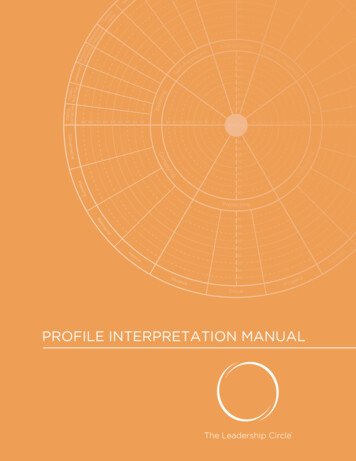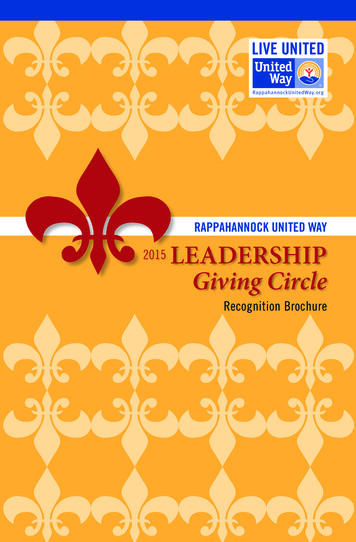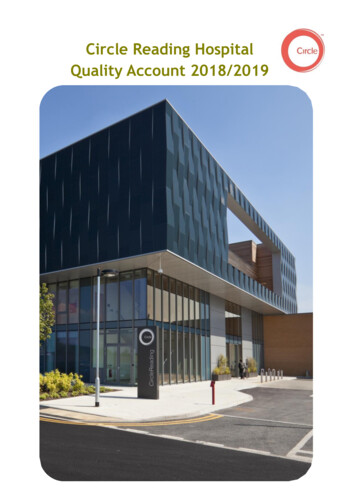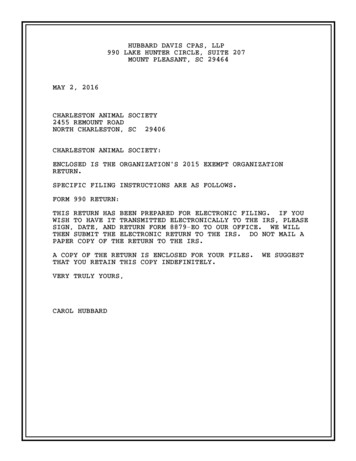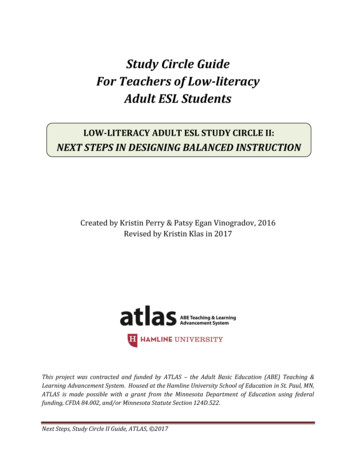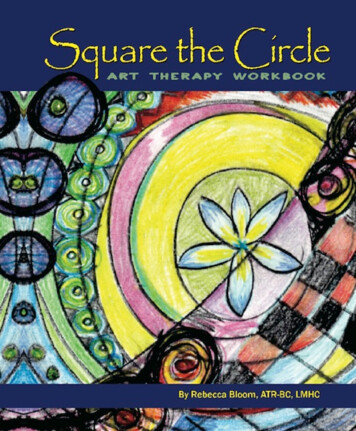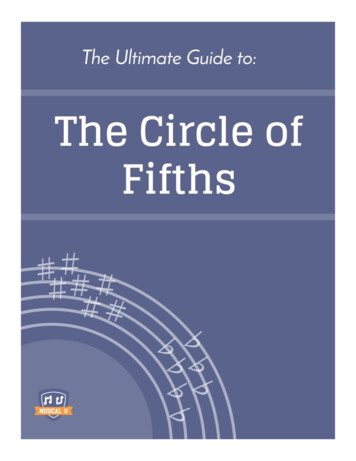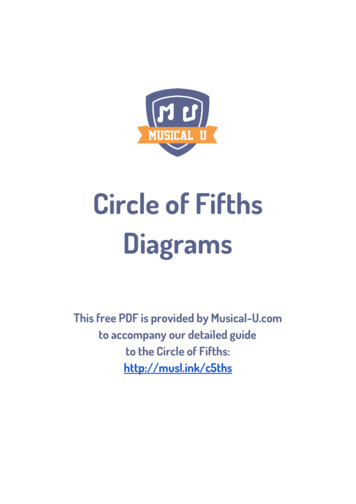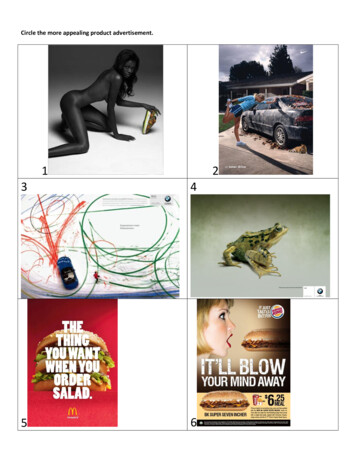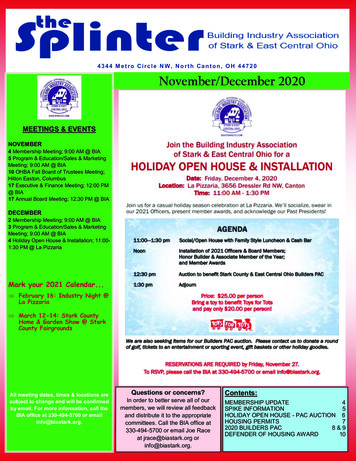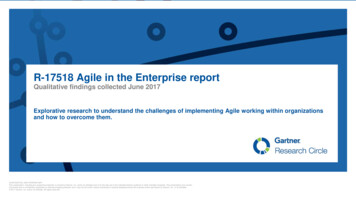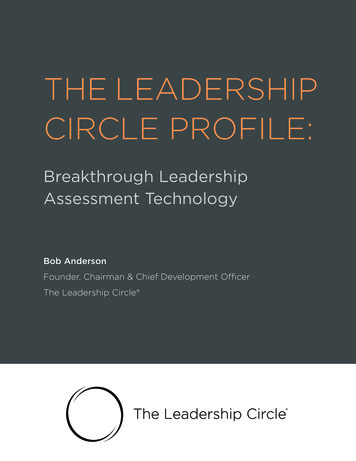
Transcription
THE LEADERSHIPCIRCLE PROFILE:Breakthrough LeadershipAssessment TechnologyBob AndersonFounder, Chairman & Chief Development OfficerThe Leadership Circle
The Leadership Circle ProfileBreakthrough Leadership Assessment TechnologyA Conscious Practice of BecomingABSTRACTPURPOSEThe purpose of this paper is to describe The Leadership Circle Profile as a significant advancement inleadership assessment and development technology.DESIGN/METHODOLOGY/APPROACHThis paper will describe how The Leadership Circle Profile integrates many of the best psychological,leadership, and spiritual development frameworks and theory into an integrated competency-basedleadership assessment.FINDINGSIn addition to describing The Leadership Circle Profile, the article will summarize key statisticalinformation that suggests the underlying validity of the instrument. It will also show how the majordimensions measured by the Profile are correlated to Leadership Effectiveness and a BusinessPerformance Index. A full description of the validity data and research methodology is beyond thescope of this paper.ORIGINALITY/VALUEOrganization Development consultants and executive coaches will discover a new leadershipassessment technology that goes beyond what is available in other tools, in that, it is a more completemodel of leadership development; immediately brings the key internal and behavioral issues to thesurface; and invites the client to work more deeply and transformationally within themselves.KEY WORDS360 degree leadership assessment instrument, developmentPAPER TYPETechnical.2 The Leadership Circle All Rights Reserved
The Leadership Circle ProfileBreakthrough Leadership Assessment TechnologyA Conscious Practice of BecomingINTRODUCTIONThe Leadership Circle Profile (TLCP) represents a significant advancement in the state-of-the-art ofleadership assessment and development. It is the first competency-based 360 assessment tool tomeasure behavior at various stages of adult development; to link patterns of action with habits ofthought; to organize information into a developmental system based on some of the best theoreticalframeworks in the leadership, psychological and spiritual literatures; and to display information in a waythat immediately draws attention to the most critical information in the feedback.DESIGN CRITERIAThe Leadership Circle Profile (TLCP) makes major advances on the best 360 instruments. TLCP isdesigned to measure a battery of key leadership competencies. Most high quality 360 instruments havea solid research base and measure competencies shown to relate well to leadership effectiveness andto outcomes important to business. TLCP was designed to do this as well as any tool on the market.In the recent book, Extraordinary Leaders, Zenger and Folkman state that the research on leadershipcompetencies can be boiled down to 16 key competencies that significantly enhance leadershipeffectiveness. TLCP measures a strikingly similar set of key competencies and establishes itself amongthe best 360 instruments available. It is the other design criteria, however, that set it apart.The Leadership Circle Profile is designed to integrate many of the best theoretical frameworks fromthe Leadership, Adult Development, Psychological and Spiritual bodies of knowledge. Few, if any, 360tools have a theoretical framework to complement their research base. TLCP has a rich and integratedtheory base. This allows practitioners to use multiple frameworks that help the client connect the datato deeper insight.The Leadership Circle Profile is designed to measure behavior and assumptions simultaneously. Inthis way, it connects patterns of leadership behavior with habits of thoughts. It does not measureassumptions directly, but measures behaviors that are associated with assumptions—well researchedby cognitive psychologists (Burns, Ellis)—and that are giving rise to high and low 360 results. In thisway, TLCP helps the client get beneath the behavior to the automatic thought processes that underliebehavior. It facilitates far deeper insight, and as a result, more possibility for transformation.The Leadership Circle Profile is also designed to point to stages of adult development. Kohlberg, Kegan,Gilligan, Cook-Grueter, Hall, Beck, Wilber and others have shown that adults can evolve into morecomplex “operating systems” through which they think and act. With greater complexity comes greatercapacity. TLCP is designed to measure thinking and behavior that is likely to arise at various stages ofdevelopment. In so doing, TLCP becomes a platform for transformation.The Leadership Circle Profile integrates all of the above in such a way that the consultant/coach andclient can immediately see the significant patterns in the data. Data is visually displayed so that theclient is naturally drawn toward the most important issues. Most 360 tools display data as sequentiallist of competencies. TLCP organizes information in a high impact way so that the client immediatelybegins to inquire into the interrelationships between behaviors.3 The Leadership Circle All Rights Reserved
The Leadership Circle ProfileBreakthrough Leadership Assessment TechnologyA Conscious Practice of BecomingTHE CIRCLE: A DEVELOPMENTAL MODELEverything stated above is represented in the Circle Graphic. Much of this article will describe thedimensions arrayed in the Circular Profile (Figure 1) and how the layout of the circle meets all of thedesign criteria mentioned above.The Graphic is composed of an inner circle and an outer circle. The outer circle contains all of thedimensions measured by TLCP. (A discussion of each is beyond the scope of this paper. For moreinformation, the reader can go to www.theleadershipcircle.com.) The inner circle summarizes the 29dimensions of the outer circle into eight inner-circle summary dimensions. Each wedge of the innercircle summarizes the dimensions in that wedge of the outer circle. The inner circle provides immediateinsight into the predominant patterns in the data. The outer circle provides specific detail as to what ismaking up that pattern.All data is compared to a norm base (of over 3000 self-assessments and 30,000 feedbackassessments) and presented as percentile scores. This allows for immediate comparison to normativepopulations, but more importantly, it distills information usually lost when only raw data is presented.Self-assessments are presented as a dark line and the average percentile score from feedback-providersis presented at the outer edge of the shaded area.Figure 1: The Leadership Circle Profile Graphic4 The Leadership Circle All Rights Reserved
The Leadership Circle ProfileBreakthrough Leadership Assessment TechnologyA Conscious Practice of BecomingThe top half of the circle is labeled Creative and the bottom half, Reactive. The top half of the circlecontains an array of 18 Creative Competencies. These are competencies that have been shown, throughthe leadership research, to be highly correlated to effectiveness and business outcomes.The split in the top half and the bottom half of the Circle points to a number of developmentalframeworks. The labels Creative and Reactive refer to Robert Fritz’s (The Path of Least Resistance)description of the Creative and Reactive Orientations. In the Creative Orientation, people are primarilyfocused on what they want and bringing into being results that matter. In the Reactive Orientation, theyare focused on problem resolution—reacting against the problem to relieve the stress, anxiety and innerconflict that the problem is causing. Fritz argues that these two orientations produce very differentpatterns of results over time. The Creative Orientation more predictably creates intended results, whilethe Reactive Orientation tends toward maintaining the current situation.Larry Wilson described these two orientations as, Play-To-Win versus Play-Not-To-Lose. Playing to winis defined not as competitive, but as, “Going as far as you can using all that you’ve got.” He describesthe bottom half as Play-Not-To-Lose. In the Play-Not-To-Lose orientation, the focus is on minimizingrisk, self-protection and self-promotion. While very common, it is not a prescription for effectiveness.The largest framework that the top-half and bottom-half points to is the research on stages of adultdevelopment. We know that children, as they grow, move through different “operating systems.” Achild at age five lives in the magical kingdom where Santa can go around the world in one night, comedown every chimney, eat everyone’s cookies, get presents to every house on the planet. This worksin a five year olds’ operating system. By age nine, the child is reading the Guinness Book of WorldRecords. Things now have measure and form. They do not shape shift. The child lives in a very differentreality and relates to the world very differently. Developmental Psychologists call this stage ConcreteOperations. Adults can, likewise, move into and through similar shifts in their operating systems—ifthey grow. There is a substantial amount of research describing these different adult operating systems(Robert Kegan, Ken Wilber, Carol Gilligan, Brian Hall, Lawrence Kohlberg, Don Beck, Susan CookGreuter, Bill Torbert, and the mystical traditions of all religions). All the research suggests that witheach evolution in the operating system comes greater capability to handle increasing complexity withgreater effectiveness.The Leadership Circle Profile has been most heavily influenced by the work of Robert Kegan at Harvard.Kegan has developed a five-stage model. Stages three and four correspond respectively to the Reactiveand Creative Orientations described above. Kegan’s research, confirmed by others, suggests that onlyabout five percent of adults evolve beyond the Creative Orientation. About 20 percent of adults fullyconfigure at the Creative level of development. Seventy percent of adults are operating at the Reactiveor in the transition from Reactive (level 3) to Creative (Level 4).In the Reactive stage, the self-structure or self-concept is organized such that identity is rooted in thesurround. Identity, self-esteem, self worth, and security are made up from the outside-in—by how oneis seen by others; by the internalized messages that one has been given from some external authorityin the surrounding environment. These messages inform one about who one is, and how one needs tobehave in order to be effective, good, or right. These internalized messages are held as unquestioned5 The Leadership Circle All Rights Reserved
The Leadership Circle ProfileBreakthrough Leadership Assessment TechnologyA Conscious Practice of Becomingor unexamined assumptions that run behavior. Because they connect ways of behaving with selfworth and security, and because they are not conscious, the manager has little choice but to behave inhabitual ways. Behavior is therefore reactive—it is run in reaction to outside events by unconscious innerassumptions.When this operating system shifts to the Creative orientation, the assumptions that equate worth orsecurity with behavioral strategies, become objects of conscious reflection. Behavior is not reactive,but choice-full. This is because the Self is much more internally organized—what psychologists callInternal Locus of Control. At this stage of development, new questions emerge. The person begins todifferentiate from the culturally accepted messages and begins to seriously ask, “What is my vision?What are my values? Who am I anyway and what do I most want to do with the time I have left in mylife?” The person is now acting in the world from his/her own internal compass; his/her own internalstandards, and set of values that have been discerned out of all of the surrounding messages. Theperson is, therefore, living and leading much more autonomously or independently in the world.In his book, In Over Our Heads, Robert Kegan evaluates many of the major literatures that adults arereading—parenting, couples, work, etc. He makes an interesting conclusion. Kegan shows how all thisliterature is prescribing very different kinds of behaviors and actions in the world, but then goes on toshow how each makes the same demand on consciousness. In other words, all the literatures that adultsare reading to help them be more effective are written to a level-four operating system. These bodiesof literature are making a level-four (Creative) demand on consciousness. This includes the leadershipliterature and competency research. Key Competencies are primarily level-four behaviors. In otherwords, they are most readily accessed when the Self is fully configured at level four. The way we havebeen describing leadership, and the competencies required to embody it, are most readily available inthe Creative Orientation.In summary, the top half of the circle is composed of Creative Competencies that are fully accessibleonly when operating out of a Creative, level four, independent operating system.The bottom half of the circle describes earlier versions of these Creative Competencies. The bottomhalf measures developing strengths—strengths that are emerging through, and still held within, aReactive operating system. Therefore, the bottom half of the Circle is not measuring weaknesses;in fact, there are many strengths associated with the bottom half—strengths that have not yet fullymatured into their Creative counterpart. The earlier version of high Achieving competencies areControlling behaviors. The earlier version of Relating competencies are Complying behaviors, and theearlier version of Self/System Awareness and Authenticity is Protecting.Given that the bottom-half strengths are being run through a Reactive operating system, eachdimension measured does have built in limitations. Limitations result because the basic assumptionunderlying each dimension is some form of worth, security, and identity equated to that specificbehavioral strategy. As soon as we say we ha
THE CIRCLE: A DEVELOPMENTAL MODEL Everything stated above is represented in the Circle Graphic. Much of this article will describe the dimensions arrayed in the Circular Profile (Figure 1) and how the layout of the circle meets all of the design criteria mentioned above. The Graphic is composed of an inner circle and an outer circle. The outer .
